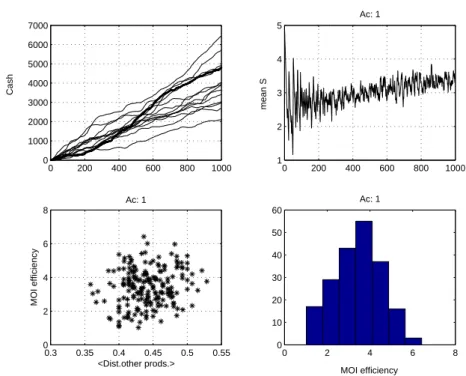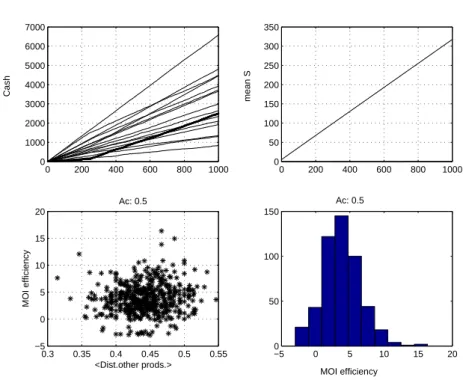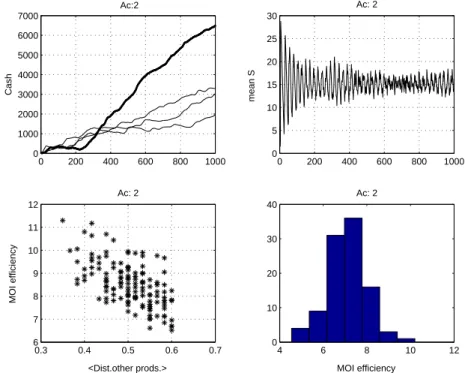Market-oriented innovation: When is
it profitable ?
An abstract agent-based study
Tanya Ara´
ujo
∗and
R. Vilela Mendes
†Research Unit on Complexity in Economics (UECE)
and ISEG, Universidade T´ecnica de Lisboa
Centro de Matem´atica e Aplica¸c˜oes Fundamentais and
Universidade T´ecnica de Lisboa
Keywords: agent-based models, innovation, artificial societies
1
Introduction
Agent-based models have been increasingly used to model artificial societies. Many of these models fall into the field of biological sciences and a very important part of them deals with economical problems ([1] [2] [3] and [4]).
Economical, ecological and social environments share as a common fea-ture the fact that the agents operating in these environments spend a large amount of their time trying to maximize some kind of actual or perceived util-ity, be it related to profit, to food or reproduction or to confort and power. It so happens that many times the improvement of one agent’s utility is made at the expense (or causes) the decrease of the other agents utilities. A general concept that is attached to this improvement struggle is the idea of innovation.
market share or with the improvement of production processes to increase profits.
In ecology, innovation concerns better ways to achieve security or food intake or reproduction chance and, in the social realm, all of the above eco-nomical and biological drives plus a few other less survival-oriented vanity needs. In all cases, innovation aims at finding strategies to better deal with the surrounding environment and to improve some utility. In any system where at least some agents are trying to innovate, the perfect strategy of today may, with time, become a loosing one. It is the well known “red queen effect”: You must run as fast as you can to stay in the same place.
Because money is a “serious matter”, it is in the economy field that innovation has been more extensively studied and codified. Three main types of innovations were identified:
(i)Market innovation: the identification of new markets and finding out how they are better served or how they may become more receptive to the available products
(ii)Product innovation : the identification and development of new prod-ucts
(iii) Process innovation : the identification of better and less expensive
production ways or the improvement of internal operations
Although these classification types were developed for economics, it is an easy exercise to find the corresponding notions in the other environments.
That also applies to the classification of the intensity of the innovations as
radical, incremental, architectural and modular. An important point to em-phasize is that the intensity of the innovation is an agent-dependent concept. An innovation that is radical for one agent might just appear as incremental or of any other type to some other agent [5]
An important concept concerning a system of innovation is the flow of in-formation within the agents of the system and its appropriation in terms of knowledge. However, here, systems of innovation are not assumed. They may only appear as emergent features.
2
The Model
In the model there are 2N agents: N producers and the same number of
consumers. Each consumer has a set of needs coded by a string of k bits and each producer has a product coded by a string of k bits . The bit string
of a consumer represents what the consumer agent needs to receive from the
environment and the bit string of a producer is a code for theproductsthat he
is able to supply. Because no passive actors are assumed in the environment, the environment for each agent is just the set of all the other agents.
In addition to the two bit strings that code for needs and products, each
agent has a scalar variableS orC, depending on the agent type (consumer or
producer, respectively). The variable S represents the degree of satisfaction
of the needs and C represents the amount of some commodity (or Capital)
that may be exchanged for the products that are available.
In the economy this role is played by money, but in other contexts it might be protection capacity or power or status.
The dynamics of the model is characterized by exchange, evolution and
adaptation. The basic driver of the exchange dynamics of the model is the matching between needs and products. At each time step, the mathching between needs and products is made and each agent chooses at random one among the products that better match his needs. The agent that has this product is a potential supplier. That is
Si(t+ 1) =Si(t)−ac+
q∗
ij
k (1)
Cj(t+ 1) =Cj(t)−ap+
Pk j(i)
q∗
ij
k (2)
The indexj(i) runs over all the agents j that are supplied by the agent i
On receiving a product from the producer i the consumer j increases
his Satisfaction (or energy) S by qij∗
k −ac. At the same time, the producer
j increases his Commodity (or cash) C by Pkj(i) qij∗
k −ap, where ac and ap
stand for two constants costs of living that are subtracted at each time step
from consumers-satisfaction and suppliers-cash, respectively. The variable q∗
At each time step needs and products are compared. The producer that supplies each consumer is chosen at random among those with larger
match-ing. When Ci < 0 this producer i disappears. When Sj < 0 this consumer
j is replaced by a new one with random needs string and Si =S0. As such,
a consumer only remains in the field as long as its energy S is positive. If it
becomes negative, he dies and is replaced by a new random agent. Initially
all agents and the replacement agents are endowed with the same initial C0
and S0.
Once the number of surviving producers stabilizes there are several pos-sible innovation mechanisms.
• Market-driven: the innovation producer finds the consumers that have a matching above a certain threshold and flips the worse bit.
• Process innovation corresponds to a price decrease plus half a point of bonus in matching.
• Finally pure productthe innovation producer finds the consumers that
have a matching above a certain threshold and develop a new product string accordingly to their need bits.
There are of course some important features of real markets that are not explicitly included in our abstract codification of the products offered by each agent. For example, products sometimes have some core features that are fixed and some others that are adjustable. Then the agent may supply the
same core product to different customers as different offerings. This market
segmentation technique is particularly important in the service industry [7] [6].
3
Results and Discussion
The model is tested for different values of ac and one looks for correlations
between the nature of the market and the effectiveness of the innovation process.
0.3 0.35 0.4 0.45 0.5 0.55 0
2 4 6 8
MOI efficiency
<Dist.other prods.> Ac: 1
0 2 4 6 8
0 10 20 30 40 50 60
Ac: 1
MOI efficiency 0 200 400 600 800 1000
0 1000 2000 3000 4000 5000 6000 7000
Cash
Ac:1
0 200 400 600 800 1000 1
2 3 4 5
mean S
Ac: 1
Figure 1: stable environment
3.1
Interpretation
1. Market-oriented innovation is not very efficient in a market with con-sumer tastes very stable (stable environment in other contexts).
0 200 400 600 800 1000 0
1000 2000 3000 4000 5000 6000 7000
Cash
Ac:0.5
0 200 400 600 800 1000 0
50 100 150 200 250 300 350
mean S
Ac: 0.5
−5 0 5 10 15 20
0 50 100 150
Ac: 0.5
MOI efficiency 0.3 0.35 0.4 0.45 0.5 0.55
−5 0 5 10 15 20
MOI efficiency
<Dist.other prods.> Ac: 0.5
Figure 2: volatile environment
4. Inverse correlation with distance to other products and nearest com-petitor. But the correlation is strong only in a volatile environment.
3.2
Future developments
The model is also planned to contain a dual mechanism for the evolution of
the needsOn the one hand there will be a general mechanism of evolution of the needs that is not directly dependent on the exchange dynamics. It will be
implemented as follows: At each time step (after the exchanges) ak-bit string
0 200 400 600 800 1000 0
1000 2000 3000 4000 5000 6000 7000
Cash
Ac:2
0 200 400 600 800 1000 0
5 10 15 20 25 30
mean S
Ac: 2
0.3 0.4 0.5 0.6 0.7 6
7 8 9 10 11 12
MOI efficiency
<Dist.other prods.> Ac: 2
4 6 8 10 12
0 10 20 30 40
Ac: 2
MOI efficiency
Figure 3: high volatile environment
agent takes one of his need bits at random and changes it to make it equal to the majority of the the same position bit in the products. Here again the majority is computed by counting the innovating agent bits.
References
[1] Kirman, A.: Economics and Complexity, Advances in Complex Systems 7(2), 139- 155 (2004).
[4] Dawid, R., M. Reiman and B. Bullnheimer, To Innovate or Not to In-novate?, IEEE Transactions on Evolutionary Computation 5, 471-481 (2001).
[5] A. N. Afuah and N. Bahram; The hypercube of innovation, Research
policy 24 (1995) 51-76.
[6] A. Johne; Using market vision to steer innovation, Technovation 19
(1999) 203-207.
[7] K. Atuahene-Gima; Market orientation and innovation, J. of Business
Research 35 (1996) 93-103.
[8] E. N. Kaufmann; The innovation enigma, Materials Chemistry and
Physics 50 (1997) 120-123.
[9] T. Padmore, H. Schuetze and H. Gibson; Modeling systems of
innova-tion: An enterprise-centered view, Research Policy 26 (1998) 605-624.
[10] L. E. Blume and S. N. Durlauf; The interactions-based approach to


